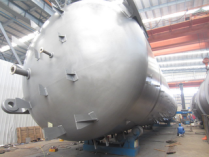Pressure Vessel Inspections

ASME Code Sharing:
The Pressure Vessel Inspections article provides you information about the inspection of pressure vessels and pressure vessel tests in a manufacturing shop. You may want to review the pressure vessel inspection procedure and corresponding inspection and test plan.
Pressure Vessel Definition - Based on the ASME Code Section VIII, pressure vessels are containers for the containment of pressure, either internal or external.
This pressure may be obtained from an external source, or by the application of heat from a direct or indirect source, or any combination thereof.
Click on the above link for detailed information about pressure vessel definition, scope, and boundaries based on ASME and API codes which specifically focus on pressure vessel inspections.
This Code section addresses mandatory requirements, specific prohibitions, and non-mandatory guidance for pressure vessel materials, design, fabrication, examination, inspection, testing, certification, and pressure relief.
You may know that ASME Code Section 8 has three divisions. Division 1 covers pressure up to 3,000 psi, Division 2 has an alternative rule and covers up to 10,000 psi, and Division 3 can be used for pressure higher than 10,000 psi.
This section is divided into three parts: subsections, mandatory appendices, and non-mandatory appendices.
Subsection A consists of Part UG, covering the general requirements applicable to all pressure vessels.
Subsection B covers specific requirements that are applicable to the various methods used in the fabrication of pressure vessels. It consists of Parts UW, UF, and UB, and deals with welded, forged, and brazed methods, respectively.
Subsection C covers specific requirements applicable to the several classes of materials used in pressure vessel construction.
It consists of Parts UCS, UNF, UHA, UCI, UCL, UCD, UHT, ULW, and ULT dealing with carbon and low alloy steels, nonferrous metals, high alloy steels, cast iron, clad and lined material, cast ductile iron, ferritic steels with properties enhanced by heat treatment, layered construction, and low temperature materials, respectively.
ASME Code Section 8 - ASME Code Section 8 is the construction code for Pressure Vessels.
